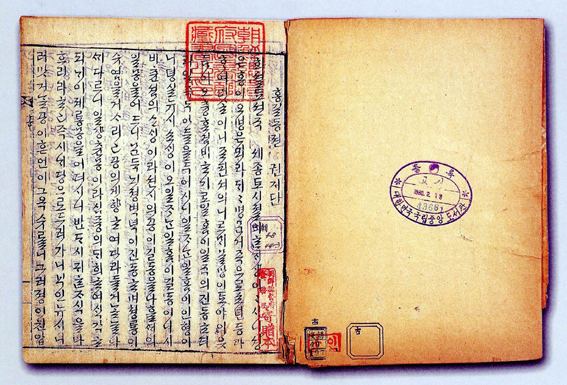Hangul 홍길동전 Revised Romanization Hong Gildongjeon | Hanja 洪吉童傳 McCune–Reischauer Hong Kildongjŏn | |
 | ||
Similar The Cloud Dream of the Nine, Geumo Sinhwa, Chunhyangjeon, Memoirs of Lady Hyegyeong, Samgungnyusa | ||
Tale of hong gil dong the first novel published in hangeul
Hong Gildong jeon (Hangul: 홍길동전; hanja: 洪吉童傳) is a Korean novel, often translated as The Story of Hong Gildong, written during the Joseon Dynasty. Hong Gildong, an illegitimate son of a noblemen and his lowborn concubine, is the main character of the story. Gifted with supreme intelligence and supernatural abilities, he steals from rich and corrupt aristocrats, which has drawn him comparisons to famous bandits like the English folk hero Robin Hood and Australia’s Ned Kelly. Historical sources point to the existence of a bandit named Hong Gildong who was arrested in 1500, however the character's historical inspiration was the early 16th century Korean bandit and folk hero Im Kkeokjeong.
Contents
- Tale of hong gil dong the first novel published in hangeul
- Plot
- Literary ContextThemesHistory
- Cultural Legacy
- Adaptations
- English Language Translations
- References
Since the novel first appeared, the character of Hong Gildong has become a mainstay of Korean culture and literature. In Korea today, Hong Gildong is a common placeholder name, similar to John Doe in the United States. Charles Montgomery of the website Korean Literature in Translation explains, “In Korean literature Hong Gildong is legion. He is a fixture from one of the most important early novels in Hangul – he is the first truly ‘Korean’ main character.” Professor Minsoo Kang writes in the foreword to his translation, “The Story of Hong Gildong is arguably the single most important work of classic (i.e., premodern) prose fiction of Korea, in terms of not only its literary achievement but also of its influence on the larger culture.” NPR’s Ari Shapiro explained on Fresh Air, "Sometimes, a single character can help define a country's sense of self. Here in the U.S., you might think of Jay Gatsby in The Great Gatsby or Superman. In North and South Korea, it's Hong Gildong.”
Plot
Various versions of Hong Gildong jeon exist, each including different details but following the same skeleton and timeline. The story is usually divided into three equal parts, each occurring in different settings.
The first part is set in the residence of the Hong Family. After waking from an auspicious dream, the High Minister, Hong Mo, lies with a lowborn maid, who conceives Hong Gildong. The story then shifts to Gildong’s childhood where he masters his physical, mental, and magical abilities. The first part concludes with Hong Gildong stopping an assassin’s attempt on his life and then leaving the Hong residence, unsatisfied with his status as a secondary son.
In the second part, Hong Gildong becomes the leader of a band of outlaws whom he names Hwalbindang (“league of those who help the impoverished”). Gildong and his band steal from locations where wealth is held throughout the country, like storehouses and temples. As his robberies become bolder and more frequent, he draws the attention of the King and ultimately ends up leaving the country in self-imposed exile.
The third part takes place in the country of Yul. Hong Gildong starts over with the Hwalbindang at the island of Jae and then overthrows the King of Yul to become King. He rules as a benevolent king and begins his own family at Yul, in which he treats his secondary and primary sons equally.
Literary Context/Themes/History
Authorship of the novel is generally attributed to Heo Gyun (허균), a radical intellectual who long dreamed of changing Korea into a fair society with less strict class hierarchies. Heo Gyun is said to be the author because of his radical ideas of political revolution, which are projected in Hong Gildong’s journey from secondary son to king. It is believed Heo Gyun wrote the book during the late 16th or early 17th century.
However, in recent years, emerging scholarship has contradicted previously accepted theories on the authorship of Hong Gildong jeon. In a 2013 article in Azalea: Journal of Korean Literature & Culture, Minsoo Kang argues that the claim for Heo Gyun as author of the novel is based on flawed and biased scholarship. He proposes instead that the novel was written around the mid-19th century "by an anonymous writer of secondary or commoner status."
Hong Gildong is often viewed as a reflection of its time. Depending on the Heo Gyun authorship model or the one that Kang proposes, this perspective differs. Kang suggests that peace and prosperity in 18th century Korea under the rule of Yeongjo and Jeonjo allowed for increased social mobility and literacy. This led to the development of a market for popular fiction, and Hong Gildong jeon is exemplary of these kinds of novels.
There are more than thirty-four existing manuscripts of Hong Gildong jeon. Scholars are uncertain which, if any, is the original manuscript, but some evidence suggests that the pilsa 89 manuscript is the oldest surviving version.
Cultural Legacy
In addition to its reputation as a literary work, Hong Gildong jeon has become widely known in Korean culture through various adaptations across different mediums. The story has inspired films, TV shows, comics, literary re-tellings, and video games, and continues to be frequently adapted. There is a Hong Gildong theme park in Jangseong County, traditionally thought to be the character’s birthplace, and a Hong Gildong festival is held in Jangseong each year.
